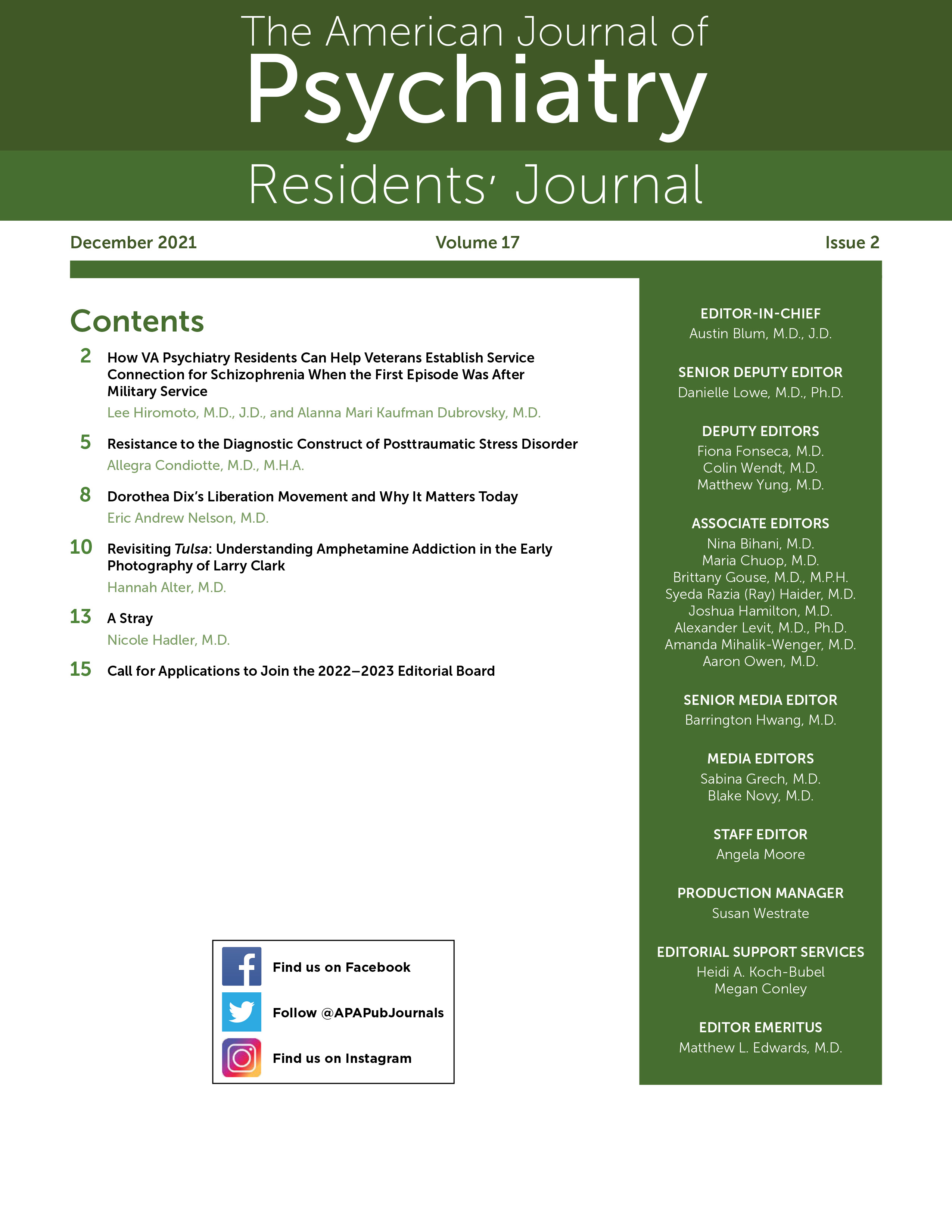Today, the concept of psychological trauma is widely accepted. Posttraumatic stress disorder (PTSD) is one of the most empirically substantiated psychiatric disorders and one of the most widely discussed in popular culture. There is nonetheless significant debate within the psychiatric community concerning its validity. Since few quantitative tests are available to differentiate between and diagnose psychiatric conditions, psychiatry categorizes illnesses based on theory, clinical observations, and epidemiological findings, resulting in variable and potentially divisive diagnostic definitions.
Modern History of Traumatology
Until the latter half of the 1800s, "trauma" referred exclusively to physical injury. The concept of psychological trauma emerged in the 1860s. During the American Civil War, combatants suffered from "soldier's heart," involving unexplained chest symptoms (
1). Soldiers in the 1870–1871 Franco-Prussian War experienced "traumatic neurosis," including chest pain, fatigue, dizziness, headache, fainting, and nightmares (
2). War was considered a trigger for these symptoms in individuals with an inherited predisposition to neurosis.
Freud's early work suggested that childhood sexual abuse could produce "hysteria," characterized by unexplained neurological and behavioral symptoms. In response to societal pressures and his own shifting frameworks, Freud replaced this conclusion with the concept of repressed desires, creating false memories of sexual experiences (
3). Hysteria was thereafter considered a result of innate vulnerabilities, with a limited role for instigating events; treatment involved drawing out the patient's repressed emotions and desires, sidestepping external events entirely.
With World War I came "shell shock," originally conceived as a neurological injury from combat (
1). After it became clear that the syndrome was psychological, the term was revised to "war neurosis," and some British soldiers were subjected to punishment in accordance with the belief that their suffering was due to weakness of moral character and lack of patriotism (
2–
4).
In 1952, the Diagnostic and Statistical Manual of Mental Disorders-I (DSM-I) included "gross stress reaction," a time-limited response of normal individuals subjected to stressors including war and natural disasters. Although the terminology was updated, the DSM-II continued this understanding, classifying trauma reactions as a transient adjustment disorder with an emphasis on individual vulnerability rather than inciting events, and an expectation that the syndrome would quickly resolve (
5).
In the 1970s, mental health professionals opposing the Vietnam War mobilized their experiences to demonstrate the negative effects of war on soldiers (
3). Originally called "post-Vietnam syndrome," PTSD was included in the DSM-III in 1980. The feminist movement then used PTSD as a platform to draw attention to sexual violence, with some thinkers specifically disputing the Freudian position that childhood sexual trauma is a result of Oedipal fantasies rather than true experiences (
3). This context brought forth the modern understanding of psychological trauma.
The definition of PTSD has shifted in each version of the DSM, moving from classification as an anxiety disorder to its own separate section. The "A criterion," or inciting traumatic event, has been altered, and symptom categorization has shifted. Current research is focused on biological correlates, specifically alterations to the hypothalamic-pituitary-adrenal axis, decreased hippocampal volume, and autonomic dysregulation (
6).
Complex PTSD: A Modern Corollary
One recent development in traumatology is the emerging diagnosis of complex PTSD (C-PTSD). First described by Judith Herman in 1992 (
3), C-PTSD is the result of prolonged interpersonal trauma. It is associated with childhood abuse or neglect, intimate partner violence, kidnapping and hostage situations, human trafficking, and more. These situations result in prolonged feelings of terror, worthlessness, and hopelessness and a deformation of one's identity and sense of self (
14).
Although DSM has not adopted the diagnosis, it is included in ICD-11. It resembles but is distinct from PTSD, somatization disorder, dissociative identity disorder, and borderline personality disorder. Initial studies have shown that PTSD and C-PTSD are distinguishable, particularly based on symptoms involving altered sense of and disorganization of self, which are present in C-PTSD but not PTSD (
15,
16). Furthermore, despite concerns that C-PTSD may be redundant with borderline personality disorder, the diagnoses can be differentiated even when comorbid (
17,
18).
Supporters have posited that the introduction of C-PTSD could reduce diagnostic comorbidity, as C-PTSD encompasses symptoms leading to diagnoses of MDD, dysthymia, social phobia, or borderline personality disorder alongside PTSD (
16). The organization of these individuals' experiences under C-PTSD could facilitate more integrated therapeutic approaches (
19).
Although it remains to be seen how C-PTSD will be incorporated into widespread psychiatric practice, the diagnosis merits further consideration and could help to increase nuance in the psychiatric community's understanding of trauma.
Conclusions
The primary duty of a clinician is toward the patient, but practice sometimes outpaces understanding. Treatments and medications are prescribed because they appear to improve patients' daily functioning and health outcomes, even though we are not yet sure why or how they achieve these effects.
Whether or not PTSD uniquely "exists" when stripped of context is less meaningful than the fact that patients experience distress after traumatic events, and psychiatrists have tools to ameliorate this distress. Future work in the field of traumatology should focus on improving the diagnostic categories used to describe patients' symptoms and to develop effective treatments.
As the history of traumatology demonstrates, caution is warranted when incorporating new concepts into diagnostic paradigms. Our increasing yet limited understanding of the brain precludes the use of biological evidence as theoretical underpinning. However, the consideration of C-PTSD and other classifications may move the field toward a more nuanced view of trauma and expand appropriate frameworks from which mental health professionals can respond to achieve optimal clinical outcomes.
